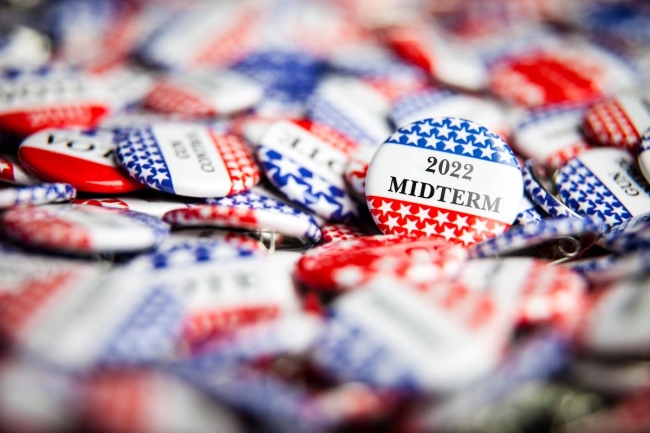You have /5 articles left.
Sign up for a free account or log in.

adamkaz/Getty Images
Advocacy groups and researchers are expecting high voter turnout among college students during the midterm elections this fall, but they will still have to overcome skepticism among younger voters who question the impact of their vote and who face a series of logistical hurdles imposed by several Republican-led states.
College students turned out en masse during the 2020 election, voting at record levels. As Election Day, Nov. 8, approaches, advocacy groups on campuses nationwide and college officials are working to register students to vote and boost turnout during what’s historically an election cycle with lower turnout. In the 2018 midterms, nearly 40 percent of college-aged adults voted, while 66 percent voted in 2020.
The midterms come as the Biden administration has worked to make voting more accessible to eligible Americans, while Republican-led states across the country are putting limits on how people can vote and where.
A spate of recently passed laws in Florida, Georgia, Texas and several other states impose additional requirements on early voting sites, shorten the time frame in which voters can request and mail in absentee ballots, and restrict the availability of ballot drop boxes—all of which can make it harder for college students to vote. Some of the states are facing lawsuits over the new restrictions, preventing them from going into effect.
“Students are generally younger, and a lot of them are the newest members of our democracy,” said Mike Burns, national director of the Campus Vote Project, a student-focused division of the nonpartisan Fair Elections Center. “They’ve maybe never voted before, or this might be, like, their second election, so it’s really a lot easier for them to get derailed by missing a voter registration deadline … There’s a lot of opportunities for something to go wrong.”
Burns said student voters often aren’t a priority for local and state election administrators despite being a large population with specific needs.
“There’s some amazing places where we’ve seen the institutions and the local election officials build great partnerships,” he said. “Unfortunately, there are a lot of places where it’s, you know, almost antagonistic.”
For example, Texas A&M University won’t have an early voting location on campus this year despite students’ effort to restore the site, The Texas Tribune reported. The Brazos County Commissioners Court decided over the summer to remove the polling location in part because of concerns about low voter turnout and complaints from nonstudent voters about navigating the campus. The university will still have a voting site on Election Day.
Congressional Democrats have tried unsuccessfully to pass a national voting rights act over the last two years, which would set standards for voter registration and expand the role of higher ed institutions and organizations in the voting process, among other changes aimed at addressing the challenges facing college students who want to vote.
In lieu of congressional action, President Biden signed an executive order in March 2021 to promote voting access. Changes from that order include making it easier to register to vote, designating two tribal colleges run by the federal government as a voter registration agency and providing resources in many different languages about voting laws for all 50 states and the District of Columbia.
Because of that order, the U.S. Department of Education sent colleges and universities a Dear Colleague letter in April outlining the requirements in the Higher Education Act of 1965 with regards to voting, including that institutions have to “make a good faith effort” to distribute voter registration forms to students.
The department also encouraged colleges and universities to work with local officials to set up drop-box locations and polling places on campuses.
Jennifer Domagal-Goldman, executive director of the ALL IN Campus Democracy Challenge, said that the department hadn’t sent a letter like that in some time.
“We were really excited that the Department of Education released a Dear Colleague letter to campuses in April reminding them of their responsibility to do nonpartisan voter registration efforts and that they can use federal work-study dollars to support students doing on-campus, nonpartisan voter registration,” she said. “We’ve definitely leaned into that and [have] used the information in that Dear Colleague letter to remind campuses of their responsibilities.”’
The ALL IN challenge works with more than 930 colleges and universities to improve civic learning, political engagement and voter participation. That effort includes creating campus action plans that outline goals and strategies to register students to vote and then remind them to actually turn out to vote.
But in a country where elections are run by the states, the federal government can only do so much.
Domagal-Goldman said the varying state laws for voting can pose an obstacle to those goals. Since 2020, she said, 19 states have passed 34 laws restricting access to voting. In the 2021 legislative session, more than 440 bills were introduced in 49 states that would have restricted access in some way. In Florida, ballot drop boxes must be supervised in person and voters have to request mail-in ballots more regularly, under new laws adopted last year. Georgia’s Election Integrity Act of 2021 shortened the time frame in which a voter can request a mail-in ballot and moved up the deadline as well as prohibited the use of mobile polling sites. The federal government sued Georgia over its new voting laws.
“We know that in states that have increased early voting or same-day voter registration … they get more voters and more younger voters to register and turn out,” Domagal-Goldman said. “We know, therefore, the opposite is the case—that you don’t see as high turnout in states that don’t have some of those pieces.”
ALL IN and other voter advocacy organizations are participating in National Voter Education Week this week, during which they’ll try to make sure students understand the rules to vote in their respective states.
Burns, who praised the Education Department’s letter when it was sent, said campuses tend to have newer and more accessible facilities that could serve as polling locations, but “we see that really be underutilized across the country.”
A study of campus voting access from the Campus Vote Project, Duke University and the MTV Entertainment Group conducted earlier this year found that in 2020, 74 percent of colleges in 45 states with the available data did not have an on-campus polling location either on Election Day or during early voting.
‘Better Than Nothing’
The Biden administration’s efforts are “certainly better than nothing, and it’s certainly better than working to actively suppress voting rights,” said Adam Gismondi, the director of impact for the Institute for Democracy & Higher Education at Tufts University.
The Institute for Democracy & Higher Education runs the National Study of Learning, Voting and Engagement, which started about a decade ago and is considered to be the best measure of whether students vote. The study also highlights colleges and universities with high voter turnouts to share strategies and tactics.
Gismondi said he’ll be watching this fall to see if the uptick in turnout in 2018 and 2020 will become a trend or a temporary increase. With the overturning of Roe v. Wade, racial equity concerns and other factors motivating younger voters, he’s expecting voter turnout to be high even without former president Trump directly involved.
“He’s not technically on the ballot this time, but a lot of divisive political figures are on the ballot this election season,” Gismondi said. “There’s also a lot of heated discussions happening on campus and off campus. The question is, is that dialogue sustained? We generally suspect that it is.”
Gismondi is also concerned about states’ efforts to limit voter access.
“What you don’t want is that in 2020, we opened up voter access and made it more equitable and more of a democratic system, and then in 2022, students find that it’s harder to vote,” he said. “We do not want that, and I think we as a society should not want that.”
Any effort to boost turnout has to overcome a “healthy dose of skepticism” from younger adults who don’t think their vote will make a difference, said Burns with the Campus Vote Project.
That skepticism makes it more important to help students overcome logistical barriers associated with voting in addition to the motivation barrier, said Burns, who added that turnout rates could “go either way.”
“We’re really making sure that we are out there and doing everything we can to remove both of those barriers: that we’re helping students get through all that logistical information but also helping them see especially the amount of impact that it did have collectively when we saw such high student and youth turnout in 2018 and in 2020,” Burns said.
Lack of Education
Teresa Cornacchione, civic engagement coordinator for the Bob Graham Center for Public Service at the University of Florida, is working to sign up new voters and educate them about the process before Election Day. Contests among student organizations to register students and between students at the University of Florida and the University of Tennessee at Knoxville have helped to boost interest in the election.
Success in those contests is gauged by the number of students who sign up in TurboVote to receive election reminders. TurboVote is an online service used by colleges and universities to help students vote by providing information about registration and sending text reminders.
“We really focused on the election reminders portion, because there are studies in political science that suggest something as simple as a text message reminder increases the likelihood someone will vote,” Cornacchione said. “Reminders keep it relevant.”
She’s also providing resources about voting and common misconceptions for faculty members to use in class.
“Especially now, I hear from students, they are very jaded,” she said. “We live in a polarized environment … I think it’s important for the students to learn how to participate and to not be discouraged by the polarization to the point where they turn away from caring about the world around them. When you talk to younger people, you realize they do care. They’re not quite sure what to do about it.”
Martha Plaehn, a first-year student at the University of North Carolina at Chapel Hill, is helping her peers sign up to vote before the state’s Oct. 17 deadline. She’s part of NCPIRG Campus Action, which is affiliated with the national Student Public Interest Research Groups and conducts nonpartisan voter mobilization drives.
After the registration deadline passes, Plaehn said, the group will shift gears to focus on educating voters about where and how to vote. Plaehn, an Asheville, N.C., native, is planning to vote absentee.
She said that oftentimes, students don’t realize they must register using their college addresses if they want to vote locally. The group’s registration efforts are focused on new students, as a result.
“A lot of people are interested in voting and interested in participating in the democratic process,” she said. “It’s just a matter of the education piece, of, ‘OK, that you actually have to register to vote, or you actually have to show up on Election Day.’ So it’s not necessarily a lack of enthusiasm, but maybe just the lack of education, I think, is a big problem that college students across the country face.”








